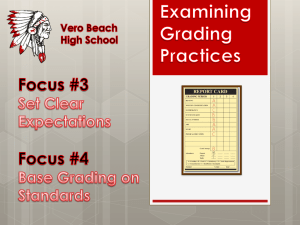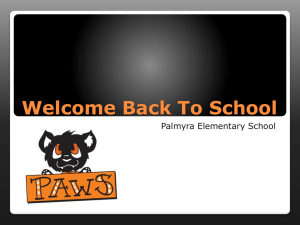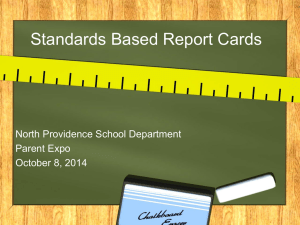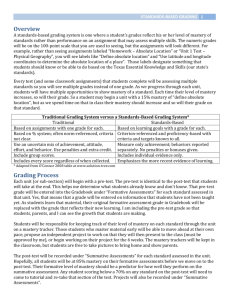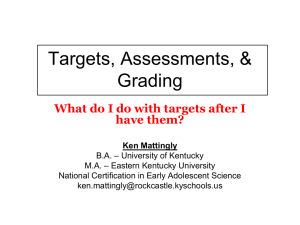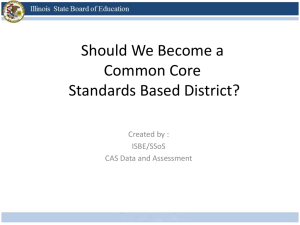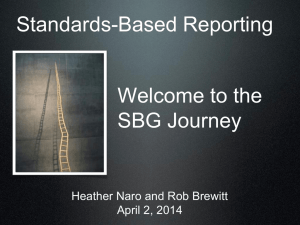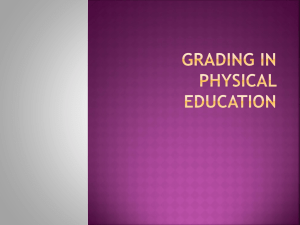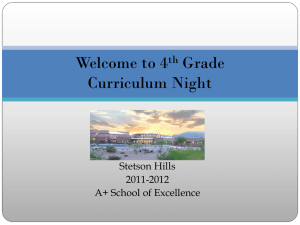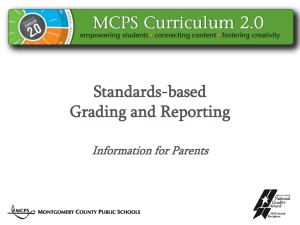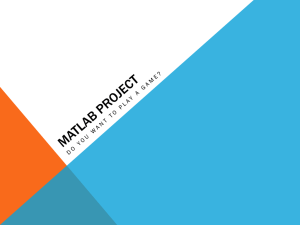Standards-Based Grading in the Science Classroom
advertisement
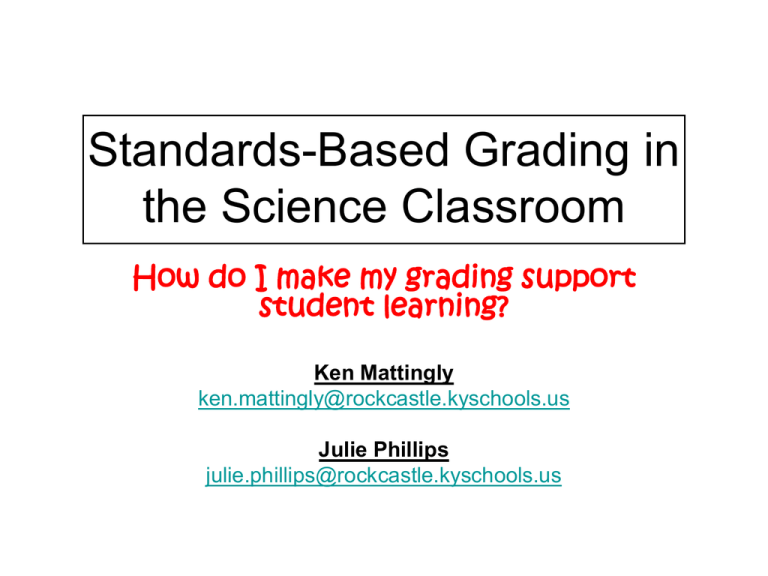
Standards-Based Grading in the Science Classroom How do I make my grading support student learning? Ken Mattingly ken.mattingly@rockcastle.kyschools.us Julie Phillips julie.phillips@rockcastle.kyschools.us Standards-based Grading • How do I make my grading: – – – – – Meaningful? Defensible? Student motivating? Teacher friendly? Infinite Campus compatible? – Administration approved? Our Job… 1. To show you how a standards-based grading system works. 2. To show you how standards-based grading can improve student motivation and performance We will do that by… 1. Sharing examples of formative and summative assessments that focus on learning targets. 2. Presenting a method for using learning targets as the structure for a standards-based grading scale. 3. Sharing examples of student opportunities to demonstrate target mastery that allows them to take ownership of their learning. Rockcastle County Middle School • • • • • 625 students grades 6-8 2 teams per grade level 70% Free and reduced lunch 2007 AI – 95, 2008 AI – 98, 2009 AI – 105 Science P+D%: – 2007: 70 – 2008: 73 – 2009: 84 Guidelines for Grading in Standards-Based Systems • Relate grading procedures to learning goals (targets) • Use criterion-referenced performance standards as references points to determine grades • Limit the valued attributes included in grades to individual achievement • Sample student performance – do not include all scores in grades • Grade in pencil – keep records so they can be updated easily • Crunch numbers carefully – if at all • Use quality assessments and properly recorded evidence of achievement • Discuss and involve students in assessment, including grading, throughout the teaching/learning process » Ken O’Connor, How to Grade for Learning, p. 44 Standards-based Grading in a Nutshell • Focuses on whether students know what you want them to know • Provides opportunities for variable learning paces • Rewards students who continue to try mastering the information/concepts • Gives a clear indication of what students know and don’t know • Gives a clear picture of where your instruction is being effective/ineffective The Backbone of a Good Standards-based system? • Learning Targets that are: – Clear to all stakeholders – Communicated to students – Measured regularly – Adjustments to learning made Student Friendly Learning Target Example • Standard: SC-07-4.6.2 Students will: – describe the transfer and/or transformations of energy which occur in examples that involve several different forms of energy (e.g., heat, electrical, light, motion of objects and chemical). – Explain, qualitatively or quantitatively, that heat lost by hot object equals the heat gained by cold object. Student Friendly Learning Target Example 1. I can give examples of energy. 2. I can give examples of energy transfer. That means when energy is moved from one object to another. 3. I can give examples of energy transformations. That means when energy is changed from one form to another form. 4. I can describe the exchange of energy between hot objects and cold objects. Clear, Student-friendly Targets • Turn knowledge, skill, reasoning, and product pieces into “I can” target statements. • Targets should use student-friendly language. • Targets should be attainable. • Provide clear, stationary targets for students to aim at and they will hit them. • Give students a copy of learning targets for the unit. Students who can identify what they are learning significantly outscore those who cannot. – Robert Marzano Assessment • Formative – Tied to how student is doing on a particular target – Use to identify growth areas and show how to close the mastery gap – Generally not included in grading of target mastery • Summative – – – – Includes assessment items for all targets in a unit Diagnoses strengths and weaknesses of student Provides road map for attaining target mastery Determines current performance on targets Using Targets for Post-Assessment Development • Matching the assessment method to the type of target. • Determining adequate sampling size. • Assessment format considerations: open response vs. multiple-choice, time constraints • Quality of questions, information value of incorrect answers Summative Feedback • Before using targets: score 65% – Student knows what questions they got right/wrong – Kept the score and went on, maybe reviewed, but still went on – No diagnosis of problems and ways to address them – perhaps taking a test again but no plan as to what to focus on – No idea on student or teacher’s part of strengths and weaknesses Summative Feedback • After using targets: score 65% – Get results broken out by target – Students know what they do well and what they need to work on – Students have opportunities to work on identified targets and gain understanding before trying again to show mastery – Diagnostic tool to show strengths and weaknesses by student and class Re-testing • Students have received summative assessment results by target • Identify targets needing improvement • Work on target practice in preparation for re-testing • Re-test only over identified targets • Evaluate results, rinse, and repeat! Our Grading Format • All assessments, formative and summative, are based on learning targets • Students’ grades are based on how well they show mastery of learning targets • Behaviors are not factored into grade unless the behavior is an identified and communicated learning target • Students are aware of targets being assessed • Students are given multiple opportunities to demonstrate mastery of targets No Grades for… • • • • • • Homework Activities Class work Behavior Quizzes Formative assessments Learning Target Performance Criterion • Student performance is divided into three categories – Basic – Developing – Mastery • Students receive a score of 1, 2, or 3 for each target depending on their performance Summative Assessment • Provides itemized feedback on performance per learning target Why Do We Need a Grade? • They will be around for a while • Parents expect and “understand” them • Students need something to compare their learning to • Communities are not ready for “no grades” • Administrators are not ready for “no grades” So Where’s the Grade? • Total points possible for each target is 3 • Total points for unit is number of targets times 3 • Students total points earned divided by total unit points gives percentage • All 2’s (developing) = 67% D • ½ 2’s and ½ 3’s = 83% low B • All 3’s (mastery) = 100% A Re-testing • Opportunities for re-teaching – Reviewing test results – Learning target practice – Classroom time • Re-test by target – Targets receiving 1’s must be worked on – Targets receiving 2’s can be worked on • Results on re-test provide information for further narrowing of mastery gap Infinite Campus • Targets are entered as different assignments • Assignment is given a name “Ecosystem Learning Target #1” • Assignment description contains the target statement • Each assignment is worth a maximum of 3 points Infinite Campus Information • Section Summary report gives a great deal of information • Reading across a student line tells how the student is doing on each target • Reading down the learning target column tells how the class is doing per target Today’s Take Home Message on Standards-Based Grading • Students are graded on their mastery of standards (learning targets) • There are communicable levels of performance leading to mastery • Only mastery of standards is included on grade calculation • Students receive multiple opportunities to show mastery of standards • Standards-based grading gives students the chance to take ownership of their performance
